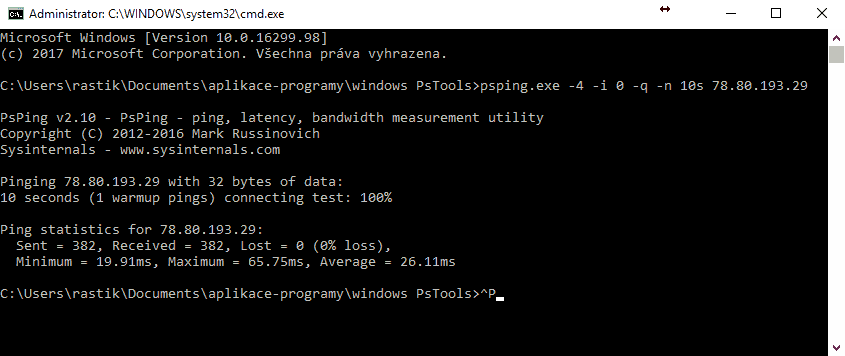PsPing - Windows ICMP flood ping

PsPing - Windows ICMP flood ping
Today I need measure a packet loss on my friend router. This is very simple task for linux, because linux has a ping -f command, what is flood ping to destination ip address.
How linux flood ping works?
For every ECHO_REQUEST sent a period ''.'' is printed, while for ever ECHO_REPLY received a backspace is printed. This provides a rapid display of how many packets are being dropped. If interval is not given, it sets interval to zero and outputs packets as fast as they come back or one hundred times per second, whichever is more. Only the super-user may use this option with zero interval.
This is output from linux ping -f command:
fw3@/var/log$ ping -f 78.80.193.29
PING 78.80.193.29 (78.80.193.29) 56(84) bytes of data.
............................................................................
............................................................................
..........................
--- 78.80.193.29 ping statistics ---
1543 packets transmitted, 1365 received, 11% packet loss, time 23372ms
rtt min/avg/max/mdev = 45.539/150.234/363.339/64.236 ms, pipe 24, ipg/ewma 15.157/269.865 ms
We can see, that packet loss from my linux station to ip address 78.80.193.29 is 11% what is very big packet loss. We can see a transmitted and received packet and min/avg/max response time too.
Windows flood ping
But for windows there is no ping -f (flood ping) option. Windows has only a basic ping utility. I googled a couple hours and I find a PsTools
from microsoft. And this basic utility package contains a utility psping
, what exactly do what I need.
So, download pstools and unzip it to any directory.
You can download pstools from this link .
And How psping works? PsPing implements Ping functionality, TCP ping, latency and bandwidth measurement. Use the following command-line options to show the usage for each test type:
Usage: psping -? [i|t|l|b]
Parameter Description
-? I Usage for ICMP ping.
-? T Usage for TCP ping.
-? L Usage for latency test.
-? B Usage for bandwidth test.
ICMP ping usage:
psping [[-6]|[-4]] [-h [buckets | ,,...]] [-i ] [-l [k|m] [-q] [-t|-n ] [-w ]
Parameter Description
-h Print histogram (default bucket count is 20).
If you specify a single argument, it's interpreted as a bucket count and the histogram will contain that number of buckets covering the entire time range of values. Specify a comma-separated list of times to create a custom histogram (e.g. "0.01,0.05,1,5,10").
-i Interval in seconds. Specify 0 for fast ping.
-l Request size. Append 'k' for kilobytes and 'm' for megabytes.
-n Number of pings or append 's' to specify seconds e.g. '10s'.
-q Don't output during pings.
-t Ping until stopped with Ctrl+C and type Ctrl+Break for statistics.
-w Warmup with the specified number of iterations (default is 1).
-4 Force using IPv4.
-6 Force using IPv6.
And It is a example of windows packet loss measurement:
C:\windows PsTools>psping.exe -4 -i 0 -q -n 10s 78.80.193.29
PsPing v2.10 - PsPing - ping, latency, bandwidth measurement utility
Copyright (C) 2012-2016 Mark Russinovich
Sysinternals - www.sysinternals.com
Pinging 78.80.193.29 with 32 bytes of data:
10 seconds (1 warmup pings) connecting test: 100%
Ping statistics for 78.80.193.29:
Sent = 382, Received = 382, Lost = 0 (0% loss),
Minimum = 19.91ms, Maximum = 65.75ms, Average = 26.11ms
C:\Users\rastik\Documents\aplikace-programy\windows PsTools>

















